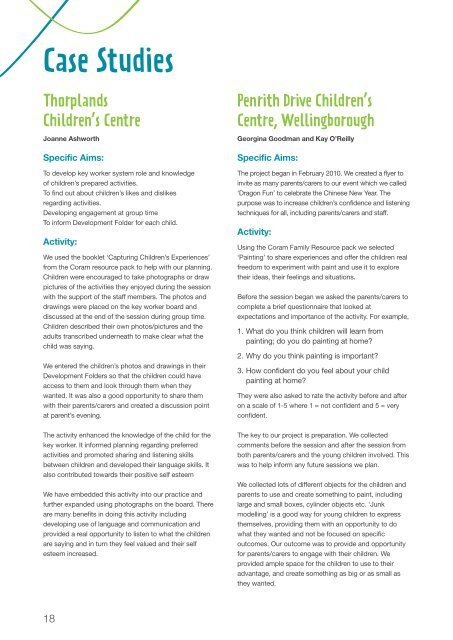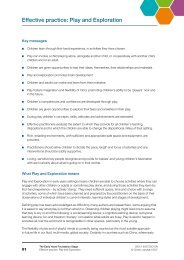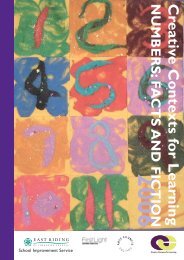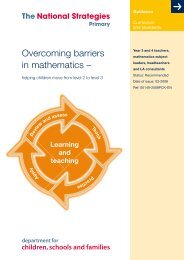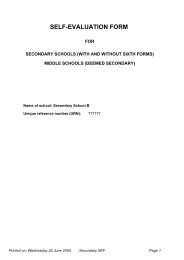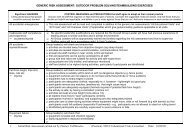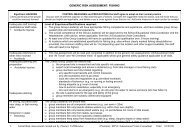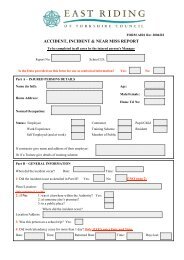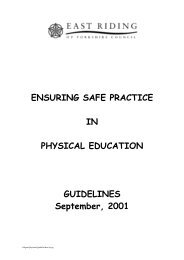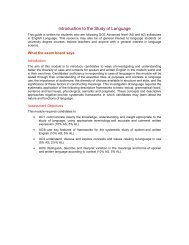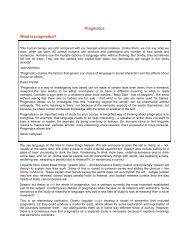Listening to Young Children - Northamptonshire County Council
Listening to Young Children - Northamptonshire County Council
Listening to Young Children - Northamptonshire County Council
Create successful ePaper yourself
Turn your PDF publications into a flip-book with our unique Google optimized e-Paper software.
Case Studies<br />
Thorplands<br />
<strong>Children</strong>’s Centre<br />
Joanne Ashworth<br />
Specific Aims:<br />
To develop key worker system role and knowledge<br />
of children’s prepared activities.<br />
To find out about children’s likes and dislikes<br />
regarding activities.<br />
Developing engagement at group time<br />
To inform Development Folder for each child.<br />
Activity:<br />
We used the booklet ‘Capturing <strong>Children</strong>’s Experiences’<br />
from the Coram resource pack <strong>to</strong> help with our planning.<br />
<strong>Children</strong> were encouraged <strong>to</strong> take pho<strong>to</strong>graphs or draw<br />
pictures of the activities they enjoyed during the session<br />
with the support of the staff members. The pho<strong>to</strong>s and<br />
drawings were placed on the key worker board and<br />
discussed at the end of the session during group time.<br />
<strong>Children</strong> described their own pho<strong>to</strong>s/pictures and the<br />
adults transcribed underneath <strong>to</strong> make clear what the<br />
child was saying.<br />
We entered the children’s pho<strong>to</strong>s and drawings in their<br />
Development Folders so that the children could have<br />
access <strong>to</strong> them and look through them when they<br />
wanted. It was also a good opportunity <strong>to</strong> share them<br />
with their parents/carers and created a discussion point<br />
at parent’s evening.<br />
The activity enhanced the knowledge of the child for the<br />
key worker. It informed planning regarding preferred<br />
activities and promoted sharing and listening skills<br />
between children and developed their language skills. It<br />
also contributed <strong>to</strong>wards their positive self esteem<br />
We have embedded this activity in<strong>to</strong> our practice and<br />
further expanded using pho<strong>to</strong>graphs on the board. There<br />
are many benefits in doing this activity including<br />
developing use of language and communication and<br />
provided a real opportunity <strong>to</strong> listen <strong>to</strong> what the children<br />
are saying and in turn they feel valued and their self<br />
esteem increased.<br />
Penrith Drive <strong>Children</strong>’s<br />
Centre, Wellingborough<br />
Georgina Goodman and Kay O’Reilly<br />
Specific Aims:<br />
The project began in February 2010. We created a flyer <strong>to</strong><br />
invite as many parents/carers <strong>to</strong> our event which we called<br />
‘Dragon Fun’ <strong>to</strong> celebrate the Chinese New Year. The<br />
purpose was <strong>to</strong> increase children’s confidence and listening<br />
techniques for all, including parents/carers and staff.<br />
Activity:<br />
Using the Coram Family Resource pack we selected<br />
‘Painting’ <strong>to</strong> share experiences and offer the children real<br />
freedom <strong>to</strong> experiment with paint and use it <strong>to</strong> explore<br />
their ideas, their feelings and situations.<br />
Before the session began we asked the parents/carers <strong>to</strong><br />
complete a brief questionnaire that looked at<br />
expectations and importance of the activity. For example,<br />
1. What do you think children will learn from<br />
painting; do you do painting at home?<br />
2. Why do you think painting is important?<br />
3. How confident do you feel about your child<br />
painting at home?<br />
They were also asked <strong>to</strong> rate the activity before and after<br />
on a scale of 1-5 where 1 = not confident and 5 = very<br />
confident.<br />
The key <strong>to</strong> our project is preparation. We collected<br />
comments before the session and after the session from<br />
both parents/carers and the young children involved. This<br />
was <strong>to</strong> help inform any future sessions we plan.<br />
We collected lots of different objects for the children and<br />
parents <strong>to</strong> use and create something <strong>to</strong> paint, including<br />
large and small boxes, cylinder objects etc. ‘Junk<br />
modelling’ is a good way for young children <strong>to</strong> express<br />
themselves, providing them with an opportunity <strong>to</strong> do<br />
what they wanted and not be focused on specific<br />
outcomes. Our outcome was <strong>to</strong> provide and opportunity<br />
for parents/carers <strong>to</strong> engage with their children. We<br />
provided ample space for the children <strong>to</strong> use <strong>to</strong> their<br />
advantage, and create something as big or as small as<br />
they wanted.<br />
18


